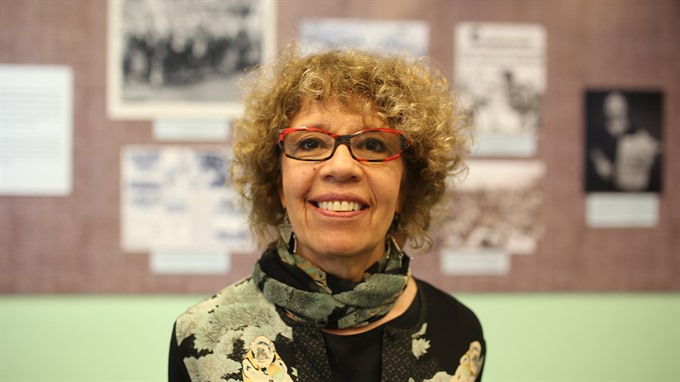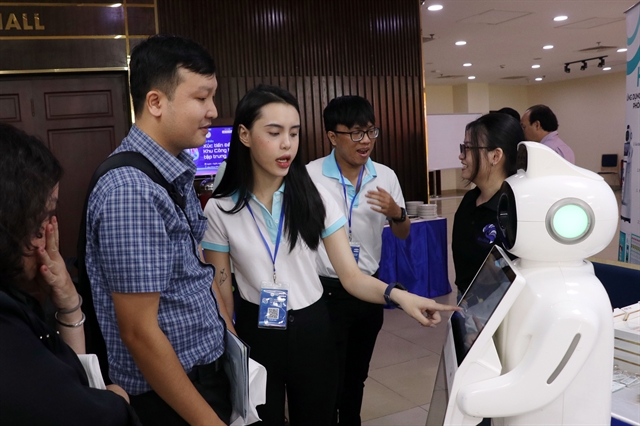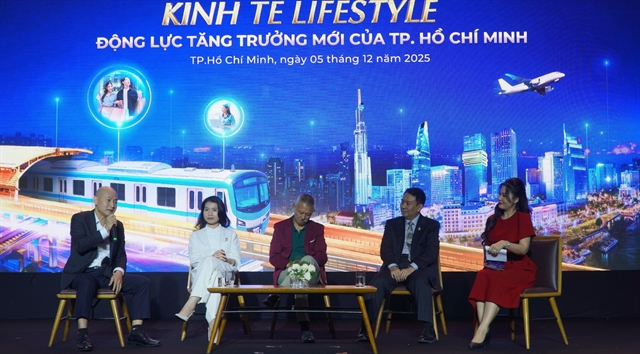 Sunday/Weekend
Sunday/Weekend

American Navy nurse Susan Schnall was dismissed from service and sentenced to six months of hard labour for protesting against the American war in Việt Nam in 1969. In March she visited Việt Nam for a fifth time with other 22 American veterans. They took part in a commemoration of the Mỹ Lai Massacre and the opening of an exhibition called Waging Peace at the War Remnants Museum in HCM City to display for the first time the newspapers, photographs, posters and films circulated underground by the GI peace movement. Việt Nam News spoke with Susan.
 |
| Nurse for peace: American Susan Schnall at the exhibition in HCM City. |
American Navy nurse Susan Schnall was dismissed from service and sentenced to six months of hard labour for protesting against the American war in Việt Nam in 1969. In March she visited Việt Nam for a fifth time with other 22 American veterans. They took part in a commemoration of the Mỹ Lai Massacre and the opening of an exhibition called Waging Peace at the War Remnants Museum in HCM City to display for the first time the newspapers, photographs, posters and films circulated underground by the GI peace movement. Việt Nam News spoke with Schnal.
How were you involved with the American war in Việt Nam?
From 1967 to 1969 I was a Navy nurse at Oak Knoll Hospital, which was built during World War II in Oakland, California, to care for Marines wounded in the Pacific. I had joined the service to alleviate suffering by caring for wounded troops from the war in Việt Nam.
It was at night that the screams of pain and fear would start at Oak Knoll. Each unit was a long wooden shack holding 40 old-fashioned steel-framed hospital beds filled with young men. At night they would dream their nightmares of war, of dead and dying buddies, rotting in the dense jungles of Việt Nam. They would scream in agony: “My leg, my leg, it’s been blown away”, “I’m in pain, Nurse, Nurse, please give me something for the pain."
On my evening shift I would make rounds through the five buildings for which I was responsible: I would open the narcotics cabinet and dispense pain medication, talking with patients, trying to soothe their fears and quieten their moans.
Why and when did you start to protest the war?
1968 was the height of the war. I watched the battles on TV and lived the war at work. For me it was very personal. My father, a Marine, was killed on the beachhead of Guam on July 22, 1944. He felt he had to do his share and help give something to this world. I never knew my father except through pictures, letters and others’ memories. World War II was a war I’ve lived my whole life. It destroyed my mother and her hopes and dreams and future.
As I cared for the wounded of yet another war, I wondered when this destruction would end. I trained the corpsmen that would be sent overseas with the troops and put in harm’s way. I helped heal the wounded so they could be returned to the frontline. I opposed this terrible destruction and waste and yet I had become a part of it. I knew I could no longer be silent.
How did you fight against the war?
As a member of the armed forces, it was imperative to inform the American people that there were active duty GIs - many thousands of us - who were against the war.
A GI and Veterans March for Peace was organised in San Francisco on October 12, 1968. We put up posters around our hospital base, publicizing the demonstration, but they were quickly torn down. We knew we had to get the word out.
The TV news showed the US Air Force dropping “informational” flyers on the Vietnamese, telling them to go to “protective hamlets” away from the fighting and spraying of deadly herbicides. If the US could drop flyers on the people of Viet Nam, then why couldn’t we drop flyers about peace in the US?
A good friend was a pilot. We rented a single engine plane, filled it with thousands of leaflets and dropped them over Bay area military bases: Treasure Island, Yerba Buena Island, Oak Knoll, the Presidio, and the deck of the USS Ranger at Alameda Naval Air Station.
One day later I was given a new Navy order stating that Navy personnel could not wear their uniforms when “participating in a demonstration with knowledge that its purpose was in furtherance of partisan views on political issues.”
I wondered about its legality since General Westmoreland wore his uniform in front of Congress, asking for more money, armaments, and troops. Why couldn’t I wear my uniform and speak out against the war? And so, I did.
The next day, along with several thousand people, including 500 active duty military, I marched down Market Street to Civic Center, wearing my uniform.
Soon the Navy determined there was enough evidence against me to convene a general court martial.
During this time I continued my nursing duties at Oak Knoll and worked on an underground paper we distributed on the base. We realised that we could speak out against the war and be heard by the American public.
On February 3, 1969, I was convicted of two charges: conduct unbecoming an officer for promoting disloyalty among the troops and disobeying a Navy regulation for wearing my uniform in a peace demonstration. I was dismissed from the service and sentenced to six months of hard labour.
What did you do after that?
I moved to New York and worked in anti-war coffee houses and I worked with a group called Medical Aid for Indochina that raised money and medical supplies for people in North Việt Nam under the Provisional Revolutionary government. Today I do a lot of work on Agent Orange, to be able to take care of the people who are harmed by the use of chemicals, the babies who continue to be born with terrible birth defects and to clean up the land. We have a small group in the US to work with and to identify the activities we are going to do. We have a group of scientists in the US to work on these issues of Agent Orange and to identify the chemicals that cause the birth defects.
What do you think about the exhibition?
I think it is wonderful to have the exhibition. It is a history that Americans don’t know about. As we have been standing here, I watched and listened to some of the Americans come through this exhibit, and they have never heard about any of it. It is important for veterans, both Vietnamese and Americans, to learn the history of this war. We have also been talking about how important it is to educate the younger generations of American soldiers, because of what we feel so strongly about is it started in Việt Nam and that we all need to tell this story about American soldiers who said that they are not going to follow everything the US government or its military wants, that they have a responsibility to take care of our own lives and to say no, we want a country that promotes humane values, health and education for our people and reach out to other countries. — VNS
| Susan Schnall is an assistant adjunct professor at the New York University School of Professional Studies, Healthcare Management. She is president of the New York City Veterans for Peace and a member of the Việt Nam Veterans against the War. For several years now she has organised scientific panels for presentations on Agent Orange at the American Public Health Association’s annual meetings. |




